2023 HYUNDAI IONIQ 6 run flat
[x] Cancel search: run flatPage 315 of 582
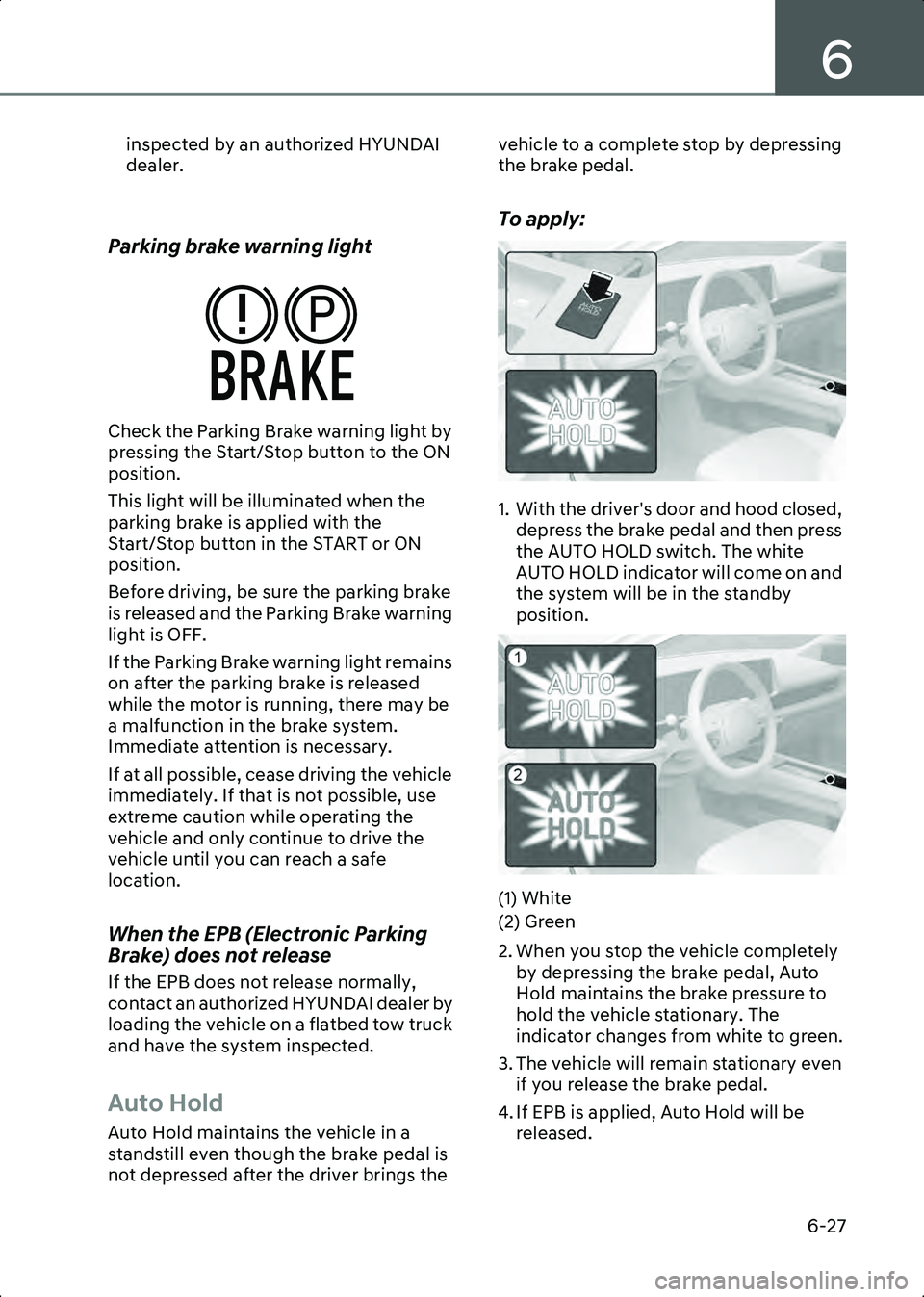
6
6-27
inspected by an authorized HYUNDAI
dealer.
Parking brake warning light
Check the Parking Brake warning light by
pressing the Start/Stop button to the ON
position.
This light will be illuminated when the
parking brake is applied with the
Start/Stop button in the START or ON
position.
Before driving, be sure the parking brake
is released and the Parking Brake warning
light is OFF.
If the Parking Brake warning light remains
on after the parking brake is released
while the motor is running, there may be
a malfunction in the brake system.
Immediate attention is necessary.
If at all possible, cease driving the vehicle
immediately. If that is not possible, use
extreme caution while operating the
vehicle and only continue to drive the
vehicle until you can reach a safe
location.
When the EPB (Electronic Parking
Brake) does not release
If the EPB does not release normally,
contact an authorized HYUNDAI dealer by
loading the vehicle on a flatbed tow truck
and have the system inspected.
Auto Hold
Auto Hold maintains the vehicle in a
standstill even though the brake pedal is
not depressed after the driver brings the vehicle to a complete stop by depressing
the brake pedal.
To apply:
B6003901
1. With the driver's door and hood closed,
depress the brake pedal and then press
the AUTO HOLD switch. The white
AUTO HOLD indicator will come on and
the system will be in the standby
position.
B6003902(1) White
(2) Green
2. When you stop the vehicle completely by depressing the brake pedal, Auto
Hold maintains the brake pressure to
hold the vehicle stationary. The
indicator changes from white to green.
3. The vehicle will remain stationary even if you release the brake pedal.
4. If EPB is applied, Auto Hold will be released.
Hyundai_CE_en_US.book Page 27
Page 326 of 582

Driving Your Vehicle
6-38
CAUTION Always drive slowly in water. If you drive
too fast, water may get into the motor
compartment, causing your vehicle to
suddenly stop.
Additional driving conditions
• Become familiar with the off-road conditions before driving.
• Always pay attention when driving off-road and avoid dangerous areas.
• Drive slowly when driving in heavy wind.
• Reduce vehicle speed when cornering. The center of gravity of AWD vehicles is
higher than conventional 2WD vehicles,
making them more likely to roll over
when you rapidly turn corners.
• Always hold the steering wheel firmly when you are driving off-road.
WARNING Do not grab the inside of the steering
wheel when you are driving off-road. You
may hurt your arm by a sudden steering
maneuver or from steering wheel
rebound due to an impact with objects on
the ground. You could lose control of the
steering wheel which may lead to serious
injury or death.
Emergency Precautions
Tires
When replacing tires, be sure to equip all
four tires with the same size, type, tread
patterns, brand and load-carrying
capacity.
WARNING Do not use tire and wheel with different
size and type from the one originally
installed on your vehicle. It can affect the
safety and performance of your vehicle,
which could lead to steering failure or
rollover causing serious injury.
WARNING
B6005201
Never start or run the vehicle while an
AWD vehicle is raised on a jack. The
vehicle can slip or roll off of a jack causing
serious injury or death to you or those
nearby.
Towing
AWD vehicles must be towed with a
wheel lift and dollies or flatbed
equipment with all the wheels off the
ground. For more information, refer to the
"Towing" section in chapter 8.
Vehicle inspection
• If the vehicle needs to be operated on a vehicle lift do not attempt to stop any of
the four wheels from turning. This could
damage the AWD system.
• Never engage the parking brake while running the vehicle on a car lift. This
may damage the AWD system.
Hyundai_CE_en_US.book Page 38
Page 446 of 582

Driver Assistance System
7-102
Surround View Monitor
Malfunction and Limitations
Surround View Monitor malfunction
When Surround View Monitor is not
working properly, or the screen flickers,
or the camera image does not display
properly, have the vehicle inspected by
an authorized HYUNDAI dealer.
Limitations of Surround View
Monitor
• The screen may be displayed abnormally, and an icon will appear at
the top left side of the screen under the
following circumstances:
- The trunk is opened
- The driver or front passenger door is opened
- The side view mirror is folded
WARNING • Always look around your vehicle to make sure there are no objects or
obstacles before moving the vehicle.
What you see on the screen may differ
from the actual vehicle’s location.
• The image shown on the screen may differ from the actual distance of the
object. Make sure to directly check the
vehicle's surroundings for safety.
• Surround View Monitor is designed to be used on a flat surface.
Therefore, if used on roads with
different heights such as curbs and
speed bumps, the image in the screen
may not look correct.
• Always keep the camera lens clean. If the lens is covered with foreign
material, it may adversely affect
camera performance and Surround
View Monitor may not operate
properly. However, do not use
chemical solvents such as strong
detergents containing high alkaline or volatile organic solvents (gasoline,
acetone, etc.). This may damage the
camera lens.
Information Surround View Monitor uses the cameras
installed on the vehicle to show images
around the vehicle through the infotainment
system. The image shown on the screen may
look unnatural depending on the
surroundings.
Hyundai_CE_en_US.book Page 102
Page 498 of 582
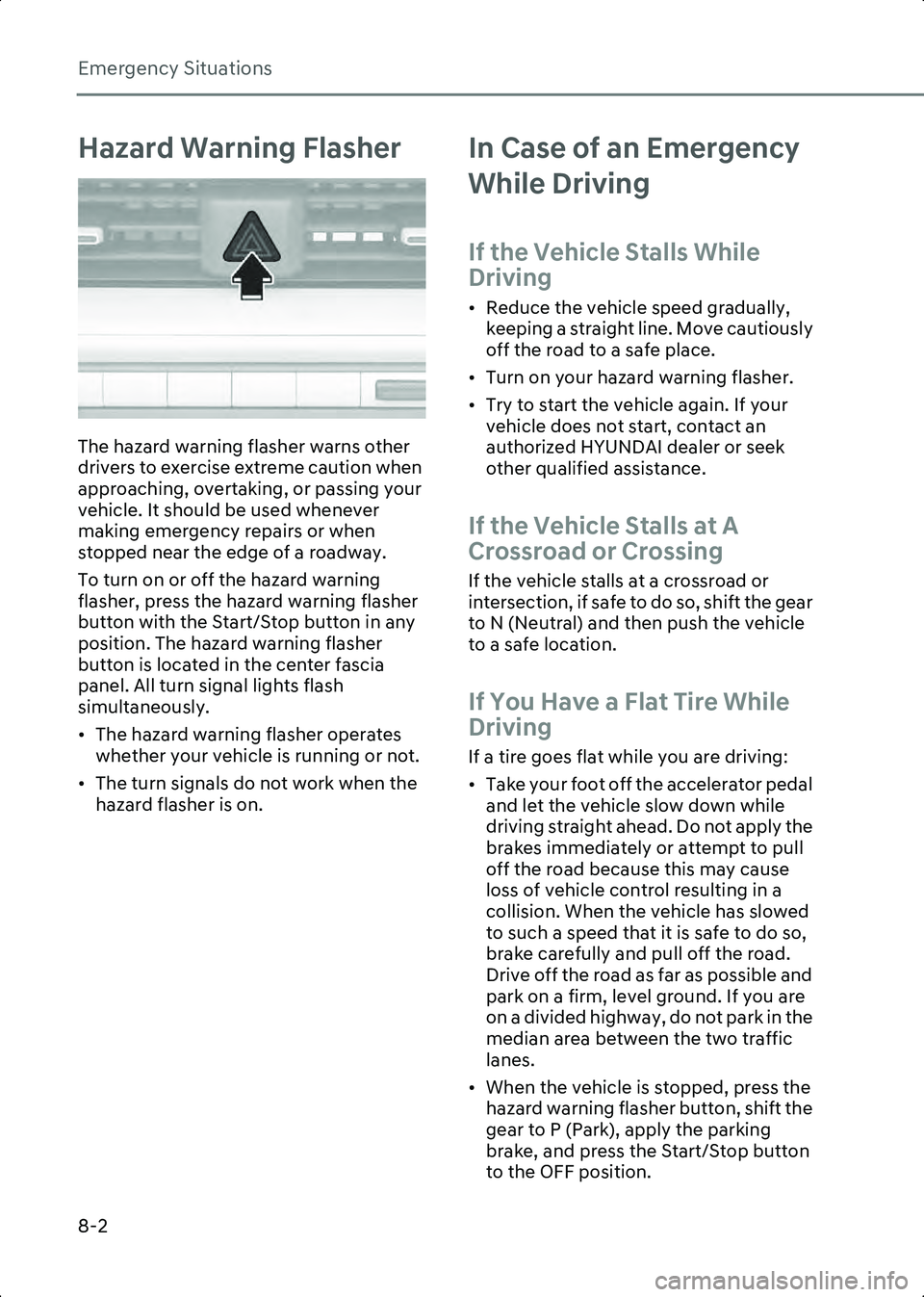
Emergency Situations
8-2
Hazard Warning Flasher
B8000201
The hazard warning flasher warns other
drivers to exercise extreme caution when
approaching, overtaking, or passing your
vehicle. It should be used whenever
making emergency repairs or when
stopped near the edge of a roadway.
To turn on or off the hazard warning
flasher, press the hazard warning flasher
button with the Start/Stop button in any
position. The hazard warning flasher
button is located in the center fascia
panel. All turn signal lights flash
simultaneously.
• The hazard warning flasher operates whether your vehicle is running or not.
• The turn signals do not work when the hazard flasher is on.
In Case of an Emergency
While Driving
If the Vehicle Stalls While
Driving
• Reduce the vehicle speed gradually, keeping a straight line. Move cautiously
off the road to a safe place.
• Turn on your hazard warning flasher.
• Try to start the vehicle again. If your vehicle does not start, contact an
authorized HYUNDAI dealer or seek
other qualified assistance.
If the Vehicle Stalls at A
Crossroad or Crossing
If the vehicle stalls at a crossroad or
intersection, if safe to do so, shift the gear
to N (Neutral) and then push the vehicle
to a safe location.
If You Have a Flat Tire While
Driving
If a tire goes flat while you are driving:
• Take your foot off the accelerator pedal and let the vehicle slow down while
driving straight ahead. Do not apply the
brakes immediately or attempt to pull
off the road because this may cause
loss of vehicle control resulting in a
collision. When the vehicle has slowed
to such a speed that it is safe to do so,
brake carefully and pull off the road.
Drive off the road as far as possible and
park on a firm, level ground. If you are
on a divided highway, do not park in the
median area between the two traffic
lanes.
• When the vehicle is stopped, press the hazard warning flasher button, shift the
gear to P (Park), apply the parking
brake, and press the Start/Stop button
to the OFF position.
Hyundai_CE_en_US.book Page 2
Page 509 of 582
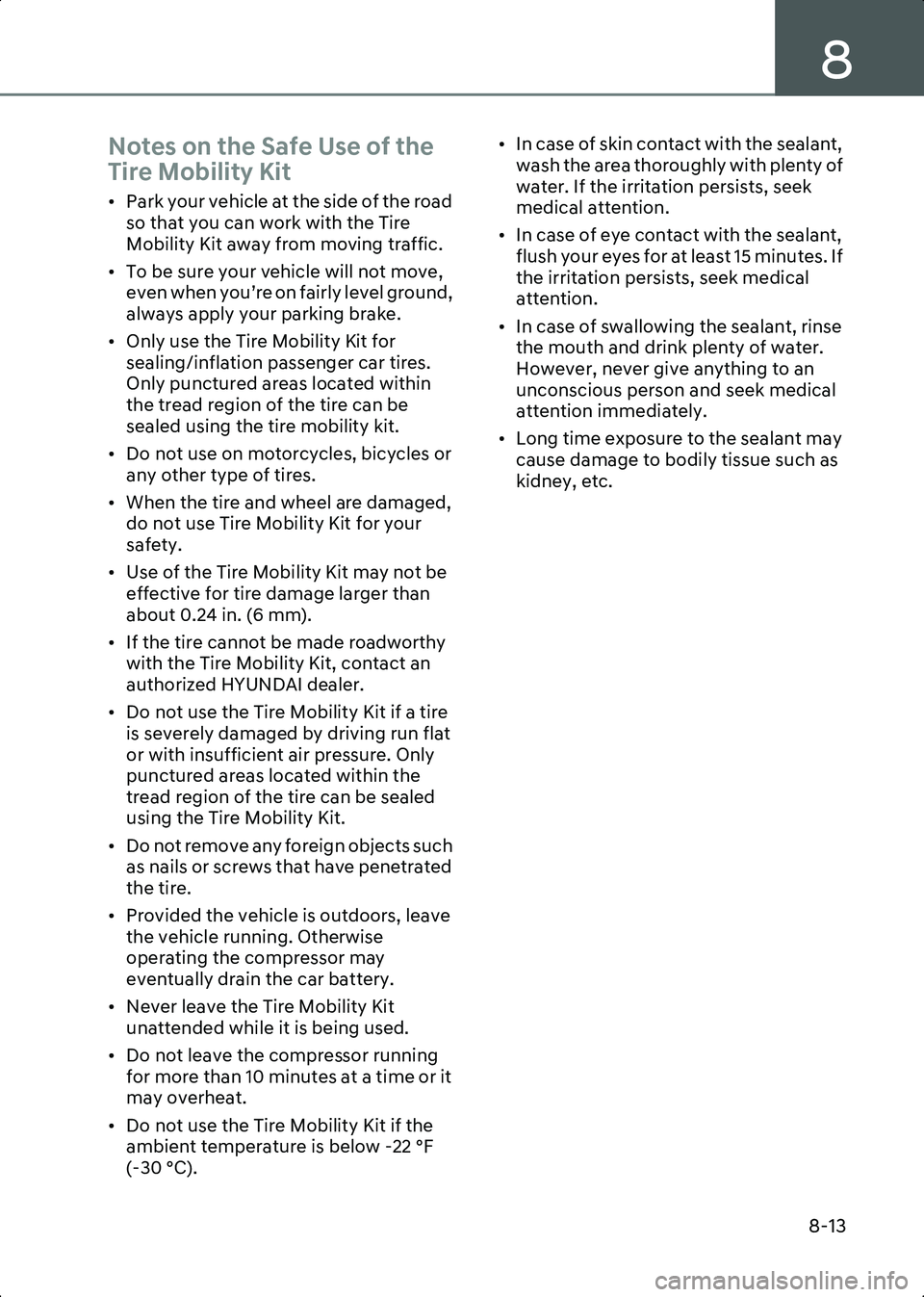
8
8-13
Notes on the Safe Use of the
Tire Mobility Kit
• Park your vehicle at the side of the road so that you can work with the Tire
Mobility Kit away from moving traffic.
• To be sure your vehicle will not move, even when you’re on fairly level ground,
always apply your parking brake.
• Only use the Tire Mobility Kit for sealing/inflation passenger car tires.
Only punctured areas located within
the tread region of the tire can be
sealed using the tire mobility kit.
• Do not use on motorcycles, bicycles or any other type of tires.
• When the tire and wheel are damaged, do not use Tire Mobility Kit for your
safety.
• Use of the Tire Mobility Kit may not be effective for tire damage larger than
about 0.24 in. (6 mm).
• If the tire cannot be made roadworthy with the Tire Mobility Kit, contact an
authorized HYUNDAI dealer.
• Do not use the Tire Mobility Kit if a tire is severely damaged by driving run flat
or with insufficient air pressure. Only
punctured areas located within the
tread region of the tire can be sealed
using the Tire Mobility Kit.
• Do not remove any foreign objects such as nails or screws that have penetrated
the tire.
• Provided the vehicle is outdoors, leave the vehicle running. Otherwise
operating the compressor may
eventually drain the car battery.
• Never leave the Tire Mobility Kit unattended while it is being used.
• Do not leave the compressor running for more than 10 minutes at a time or it
may overheat.
• Do not use the Tire Mobility Kit if the ambient temperature is below -22 °F
(-30 °C). • In case of skin contact with the sealant,
wash the area thoroughly with plenty of
water. If the irritation persists, seek
medical attention.
• In case of eye contact with the sealant, flush your eyes for at least 15 minutes. If
the irritation persists, seek medical
attention.
• In case of swallowing the sealant, rinse the mouth and drink plenty of water.
However, never give anything to an
unconscious person and seek medical
attention immediately.
• Long time exposure to the sealant may cause damage to bodily tissue such as
kidney, etc.
Hyundai_CE_en_US.book Page 13
Page 512 of 582
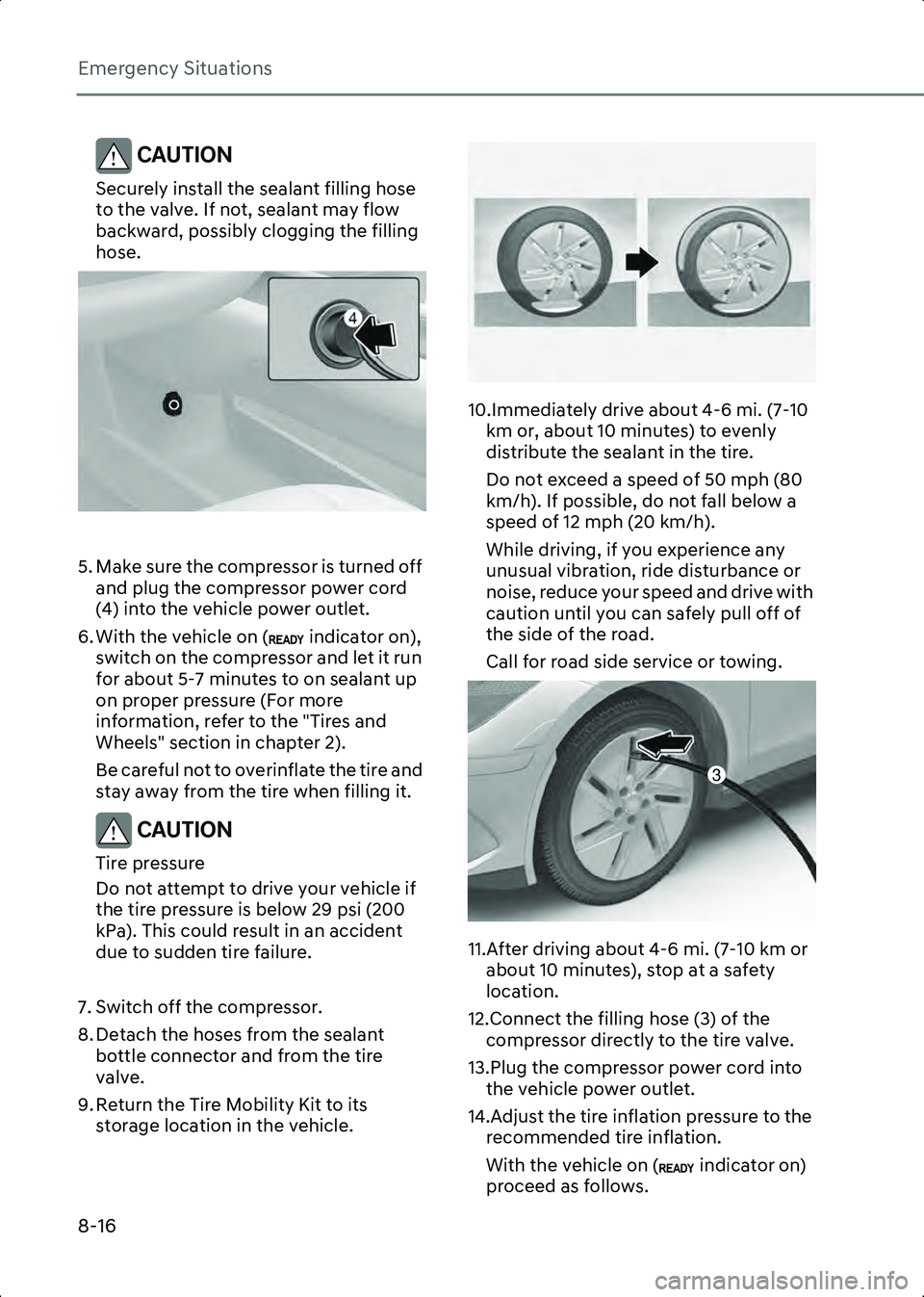
Emergency Situations
8-16
CAUTION Securely install the sealant filling hose
to the valve. If not, sealant may flow
backward, possibly clogging the filling
hose.
B8002507
5. Make sure the compressor is turned off and plug the compressor power cord
(4) into the vehicle power outlet.
6. With the vehicle on ( indicator on), switch on the compressor and let it run
for about 5-7 minutes to on sealant up
on proper pressure (For more
information, refer to the "Tires and
Wheels" section in chapter 2).
Be careful not to overinflate the tire and
stay away from the tire when filling it.
CAUTION Tire pressure
Do not attempt to drive your vehicle if
the tire pressure is below 29 psi (200
kPa). This could result in an accident
due to sudden tire failure.
7. Switch off the compressor.
8. Detach the hoses from the sealant bottle connector and from the tire
valve.
9. Return the Tire Mobility Kit to its storage location in the vehicle.
B8002508
10.Immediately drive about 4-6 mi. (7-10 km or, about 10 minutes) to evenly
distribute the sealant in the tire.
Do not exceed a speed of 50 mph (80
km/h). If possible, do not fall below a
speed of 12 mph (20 km/h).
While driving, if you experience any
unusual vibration, ride disturbance or
noise, reduce your speed and drive with
caution until you can safely pull off of
the side of the road.
Call for road side service or towing.
B8002509
11.After driving about 4-6 mi. (7-10 km or about 10 minutes), stop at a safety
location.
12.Connect the filling hose (3) of the compressor directly to the tire valve.
13.Plug the compressor power cord into the vehicle power outlet.
14.Adjust the tire inflation pressure to the recommended tire inflation.
With the vehicle on ( indicator on)
proceed as follows.
3
Hyundai_CE_en_US.book Page 16
Page 513 of 582
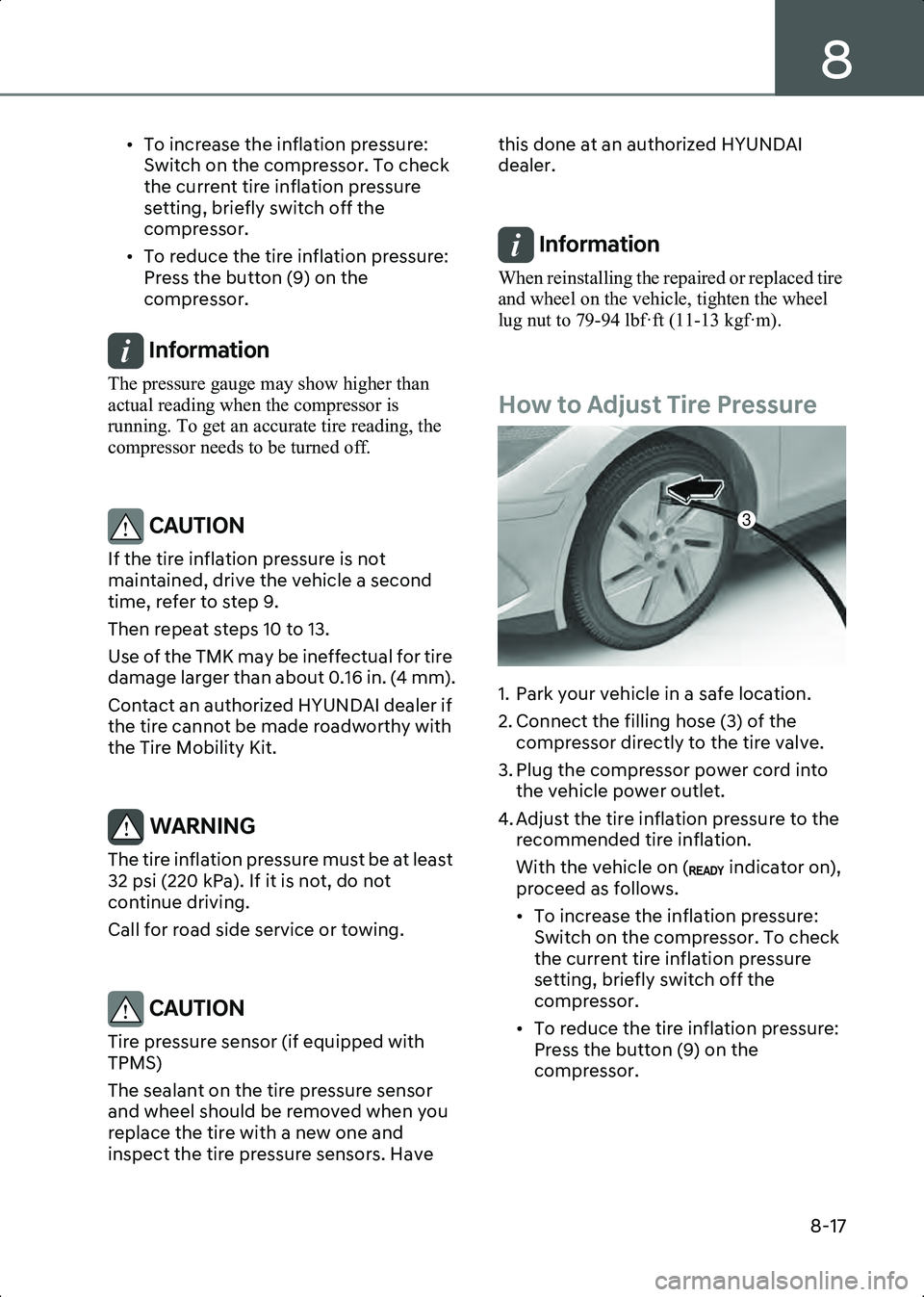
8
8-17
• To increase the inflation pressure: Switch on the compressor. To check
the current tire inflation pressure
setting, briefly switch off the
compressor.
• To reduce the tire inflation pressure: Press the button (9) on the
compressor.
Information The pressure gauge may show higher than
actual reading when the compressor is
running. To get an accurate tire reading, the
compressor needs to be turned off.
CAUTION If the tire inflation pressure is not
maintained, drive the vehicle a second
time, refer to step 9.
Then repeat steps 10 to 13.
Use of the TMK may be ineffectual for tire
damage larger than about 0.16 in. (4 mm).
Contact an authorized HYUNDAI dealer if
the tire cannot be made roadworthy with
the Tire Mobility Kit.
WARNING The tire inflation pressure must be at least
32 psi (220 kPa). If it is not, do not
continue driving.
Call for road side service or towing.
CAUTION Tire pressure sensor (if equipped with
TPMS)
The sealant on the tire pressure sensor
and wheel should be removed when you
replace the tire with a new one and
inspect the tire pressure sensors. Have this done at an authorized HYUNDAI
dealer.
Information When reinstalling the repaired or replaced tire
and wheel on the vehicle, tighten the wheel
lug nut to 79-94 lbf·ft (11-13 kgf·m).
How to Adjust Tire Pressure
B8002510
1. Park your vehicle in a safe location.
2. Connect the filling hose (3) of the
compressor directly to the tire valve.
3. Plug the compressor power cord into the vehicle power outlet.
4. Adjust the tire inflation pressure to the recommended tire inflation.
With the vehicle on ( indicator on),
proceed as follows.
• To increase the inflation pressure: Switch on the compressor. To check
the current tire inflation pressure
setting, briefly switch off the
compressor.
• To reduce the tire inflation pressure: Press the button (9) on the
compressor.
3
Hyundai_CE_en_US.book Page 17
Page 514 of 582
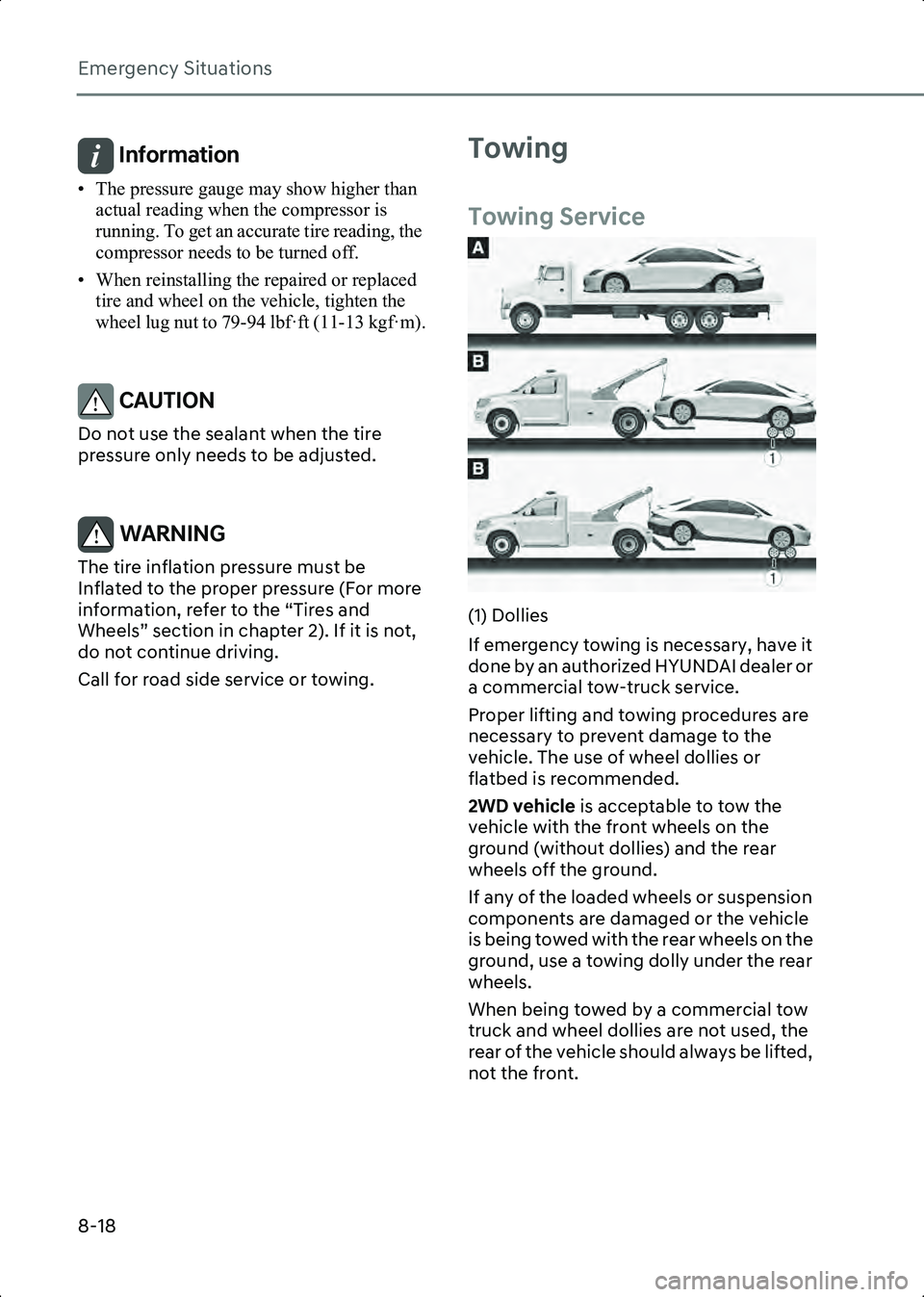
Emergency Situations
8-18
Information • The pressure gauge may show higher than actual reading when the compressor is
running. To get an accurate tire reading, the
compressor needs to be turned off.
• When reinstalling the repaired or replaced tire and wheel on the vehicle, tighten the
wheel lug nut to 79-94 lbf·ft (11-13 kgf·m).
CAUTION Do not use the sealant when the tire
pressure only needs to be adjusted.
WARNING The tire inflation pressure must be
Inflated to the proper pressure (For more
information, refer to the “Tires and
Wheels” section in chapter 2). If it is not,
do not continue driving.
Call for road side service or towing.
Towing
Towing Service
B8002701(1) Dollies
If emergency towing is necessary, have it
done by an authorized HYUNDAI dealer or
a commercial tow-truck service.
Proper lifting and towing procedures are
necessary to prevent damage to the
vehicle. The use of wheel dollies or
flatbed is recommended.
2WD vehicle is acceptable to tow the
vehicle with the front wheels on the
ground (without dollies) and the rear
wheels off the ground.
If any of the loaded wheels or suspension
components are damaged or the vehicle
is being towed with the rear wheels on the
ground, use a towing dolly under the rear
wheels.
When being towed by a commercial tow
truck and wheel dollies are not used, the
rear of the vehicle should always be lifted,
not the front.
Hyundai_CE_en_US.book Page 18